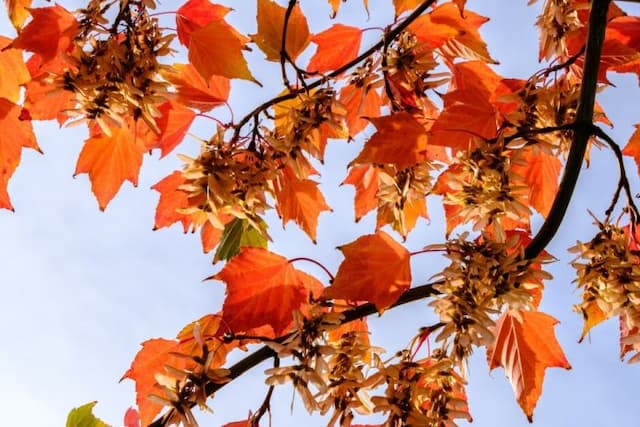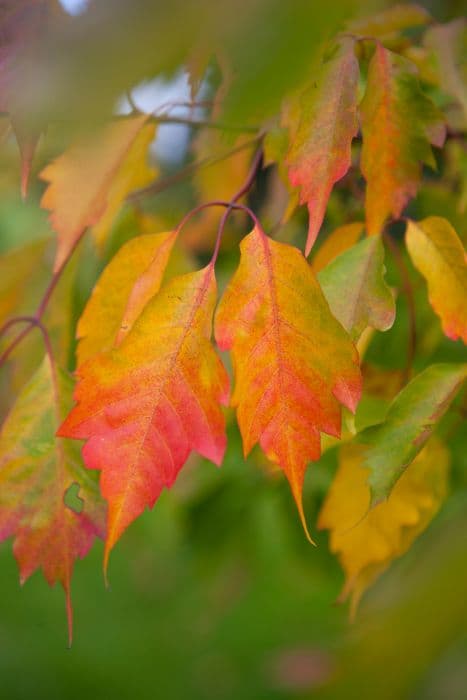Floating Cloud Japanese Maple Acer palmatum 'Uki-gumo' (P/v)

ABOUT
Acer palmatum 'Uki-gumo', also known as the Floating Cloud Japanese Maple, is a unique and visually striking ornamental tree. Its appearance is characterized by a beautiful foliage display that varies throughout the seasons. During spring, the leaves emerge with a blend of pink, white, and green. The young leaves have a soft, almost pastel palette that truly stands out. As they mature, the leaves are variegated and display a predominant white and green pattern, with traces of pink occasionally found along the edges or veins, giving an impression as if the clouds are adrift among the foliage. The leaves of this Japanese Maple are palmate, meaning they resemble a hand with outstretched fingers, and typically have five to seven pointed lobes that create a delicate, feathery look. The texture of the leaves is matte rather than glossy, adding to the soft, ethereal quality of the Floating Cloud Japanese Maple. This variegation is unpredictable and no two leaves are exactly alike, which adds to the tree's allure and makes it a compelling specimen in any garden collection. In the fall, the foliage undergoes another transformation, presenting an array of colors from light pinks to deeper shades, coupled with hints of yellow and cream before the leaves fall in preparation for winter. The bark on the branches and trunk is smooth, providing additional visual interest, especially in the winter months when the branches are bare. The Floating Cloud Japanese Maple has a layered, somewhat spreading growth habit, creating a graceful and cascading silhouette. The irregular pattern of the branches lends a natural, almost whimsical appearance to the plant, making it a focal point in the landscape. This tree is prized for its ornamental features, contributing an almost painterly quality through its ever-changing foliage and unique form.
About this plant
 Names
NamesFamily
Sapindaceae
Synonyms
Floating Cloud Japanese Maple, Uki-gumo Japanese Maple
Common names
Acer palmatum 'Uki-gumo'
 Toxicity
ToxicityTo humans
The Japanese Maple is generally not toxic to humans. Most parts of Acer palmatum 'Uki-gumo' can be handled and are not considered poisonous if ingested. Therefore, no specific symptoms of poisoning are expected from this plant for humans.
To pets
Similar to its effect on humans, the Japanese Maple is not commonly known to be toxic to pets. Ingesting parts of Acer palmatum 'Uki-gumo' is unlikely to cause poisoning in animals, and there are no specific symptoms associated with toxicity from this particular plant. However, it is always wise to monitor pets and prevent them from eating plants, as individual reactions can vary.
 Characteristics
CharacteristicsLife cycle
Perennials
Foliage type
Deciduous
Color of leaves
Variegated
Height
6-8 feet (1.8-2.4 meters)
Spread
5-7 feet (1.5-2.1 meters)
Plant type
Tree
Hardiness zones
5-9
Native area
Japan
Benefits
 General Benefits
General Benefits- Aesthetic Appeal: The Acer palmatum 'Uki-gumo', also known as the Floating Cloud Japanese Maple, offers unique variegated foliage that adds visual interest and beauty to gardens and landscapes.
- Seasonal Interest: It has a dynamic seasonal transformation, with leaves that change color throughout the seasons—pale pink in spring, white and green in summer, and vibrant shades of pink, red, and purple in fall.
- Shade Production: This Japanese Maple variant provides a dappled shade that is suitable for understory planting and creates a cool, tranquil environment.
- Compact Size: Being a small to medium-sized tree, it is well-suited for residential gardens where space might be limited, without overwhelming the landscape.
- Ornamental Bark: Even in winter, when the branches are bare, the tree remains attractive due to its ornamental bark and elegant branch structure.
- Habitat Support: It can offer habitat and some food value for wildlife such as birds and beneficial insects within the garden ecosystem.
- Low Maintenance: Once established, Acer palmatum 'Uki-gumo' requires relatively low maintenance, adapting well to a variety of soil conditions when properly cared for.
- Bonsai Suitability: It is an excellent species for bonsai enthusiasts due to its leaf and branch structure, as well as its tolerance for pruning.
- Cultural Significance: Japanese Maples are revered in many cultures, particularly in Japan, for their beauty and elegance, making them a focal point in traditional and themed gardens.
- Versatility in Landscaping: This plant is versatile and can be used in a variety of landscaping applications, including as a specimen plant, in containers, within borders, or as part of a woodland garden.
 Medical Properties
Medical PropertiesThis plant is not used for medical purposes.
 Air-purifying Qualities
Air-purifying QualitiesThis plant is not specifically known for air purifying qualities.
 Other Uses
Other Uses- Acer palmatum 'Uki-gumo', also known as Floating Cloud Japanese Maple, can be used in bonsai cultivation, where its variegated foliage and delicate structure are highly valued for their artistic appeal.
- Leaves from the Floating Cloud Japanese Maple may be pressed and preserved in books or frames as a form of botanical art or natural decor.
- This plant's wood can be carved into small objects or ornaments, taking advantage of its fine grain and the uniqueness of each piece due to the variegation patterns in the leaves reflected in the wood.
- Photographers and painters often use the Floating Cloud Japanese Maple as a subject due to its striking appearance, especially with the changing leaf colors in different seasons.
- The sap of the Floating Cloud Japanese Maple can be used in small quantities as a natural adhesive for art projects, though it is not commonly known for this use.
- In landscape design, the Floating Cloud Japanese Maple is used as a focal point in zen gardens and to create a sense of tranquility and natural beauty.
- This plant is sometimes associated with certain cultural or spiritual practices, where it may be incorporated into gardens and spaces designed for meditation or reflection.
- During certain festivals or cultural events, branches or leaves of the Floating Cloud Japanese Maple might be used as decorations or emblems, symbolizing change and the ephemeral nature of beauty.
- Floating Cloud Japanese Maple leaves can be incorporated into handcrafted paper, providing a unique texture and visual appeal to the finished product.
- The tree's fall foliage can be collected and used to create temporary natural carpets for outdoor events, providing a stunning and eco-friendly decorative element.
Interesting Facts
 Feng Shui
Feng ShuiThe Japanese Maple, which includes cultivars like 'Uki-gumo', can be used in Feng Shui to create a sense of balance and serenity. Its delicate leaves and gentle growth habit can evoke a feeling of calm, making it suitable for a garden space designed for relaxation and contemplation. According to Feng Shui principles, planting a Japanese Maple in the East can promote health and family harmony, or in the Southeast to attract wealth and abundance.
 Zodiac Sign Compitability
Zodiac Sign CompitabilityThe Japanese Maple is not used in astrology practice.
 Plant Symbolism
Plant Symbolism- Uniqueness - Acer palmatum, commonly known as Japanese Maple, has a wide variety of cultivars with distinct characteristics. 'Uki-gumo,' meaning "Floating Clouds," represents the unique beauty of the plant, suggesting a symbolism of individuality and standing out.
- Change and Transformation - With leaves that change color through the seasons, the Japanese Maple symbolizes the ever-changing nature of life and the beauty of transformation and evolution.
- Peace and Tranquility - In Japan, maple trees are often found in gardens designed for reflection and meditation. The 'Uki-gumo' with its calming appearance is no exception, symbolizing tranquility and calmness.
- Balance and Harmony - The delicate foliage and balanced growth habit of the 'Uki-gumo' Japanese Maple symbolize harmony with nature and the importance of a balanced life.
 Water
WaterFor the Floating Cloud Maple, water it deeply once a week during the growing season, ensuring that the soil remains moist but not waterlogged. During periods of drought or extreme heat, you may need to water it twice a week. The amount of water typically needed is about 2 gallons for a young tree, increasing proportionally as the tree matures. Scale back watering during the fall and water sparingly in winter, only if the soil becomes very dry.
 Light
LightThe Floating Cloud Maple thrives best in partial shade; too much direct sunlight can scorch the leaves, especially in hotter climates. It's ideally placed in a location where it receives morning sun and afternoon shade, ensuring that the light is dappled or filtered to protect its delicate foliage.
 Temperature
TemperatureThe Floating Cloud Maple prefers temperatures between 60°F and 80°F but can withstand temperatures down to -20°F and up to 90°F for short periods. Avoid exposing the plant to extremes as significant fluctuations can stress it. Its ideal growing conditions are cool to moderate temperatures throughout the year.
 Pruning
PruningPrune the Floating Cloud Maple to maintain its shape and health or to remove any dead or damaged branches, which helps encourage new growth. The best time for pruning is late winter or early spring before new growth starts. Light pruning can be done annually, but major pruning should be done less frequently, only as needed.
 Cleaning
CleaningAs needed
 Soil
SoilThe Floating Cloud Japanese Maple (Uki-gumo) thrives in well-draining, consistently moist soil with a pH range of 5.5 to 6.5. A suitable soil mix would be one part peat, one part pine bark, and one part coarse sand or perlite, which will ensure proper drainage and aeration. An addition of organic matter like compost can also enhance the soil structure and fertility.
 Repotting
RepottingFloating Cloud Japanese Maple should be repotted every two to three years to prevent root-bound conditions and renew the nutrient content of the soil. Younger trees may require more frequent repotting, while mature trees can be repotted less often. Always repot in the early spring before new growth begins.
 Humidity & Misting
Humidity & MistingFloating Cloud Japanese Maple prefers a moderate humidity level. Outdoor plants are generally in the ideal range of natural humidity, but if conditions are very dry, periodic misting or a location near a water feature can help. Avoid placing in overly arid or windy areas which can dry out leaves.
 Suitable locations
Suitable locationsIndoor
Provide bright, indirect light and ensure high humidity for Floating Cloud Maple.
Outdoor
Plant in dappled shade, shelter from harsh winds, moist, acidic soil.
Hardiness zone
5-8 USDA
 Life cycle
Life cycleThe life cycle of Acer palmatum 'Uki-gumo', commonly known as the Floating Clouds Japanese Maple, begins with seed germination, which is triggered by stratification to overcome dormancy. Seedlings emerge and grow, developing into young saplings with characteristic variegated leaves that can exhibit shades of white, green, and pink. As the sapling matures into an adult tree, it undergoes a period of vegetative growth each year, producing new shoots and leaves; the foliage is most vivid in the spring and provides a striking display. Adult trees reach reproductive maturity and produce flowers, typically in the spring; these are followed by the development of winged samaras, or seed pods, which disperse by wind in late summer or fall. The tree enters a period of dormancy in winter, losing its leaves and conserving energy until the next growth cycle begins in spring. Throughout its lifetime, which can span several decades, the plant may face periods of growth and pruning, as well as potential stress from environmental factors that can impact its overall health and longevity.
 Propogation
PropogationPropogation time
Early Spring
The Japanese maple 'Uki-gumo' is often propagated through grafting, which is the most popular method due to its reliability in reproducing the same variegated foliage of the parent plant. Grafting is typically done in late winter or early spring before the sap starts to flow. A scion, a cutting of the 'Uki-gumo' with several buds, is attached to the rootstock of a hardier Acer species. The cut surfaces of scion and rootstock are aligned and bound tightly to ensure a secure union. The grafted joint is then sealed with grafting wax or tape to prevent dehydration and infection. Over time, the tissues of the two parts grow together, forming a new, grafted Japanese maple that maintains the characteristics of 'Uki-gumo'.









